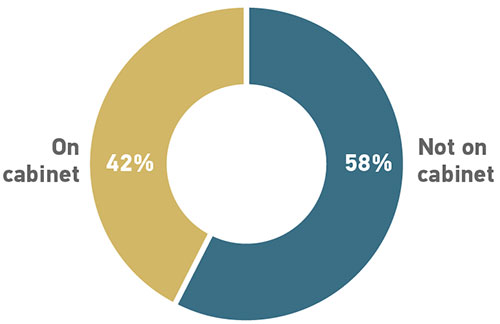Introduction and Key Findings

Introduction
Year after year, it is crystal clear that technology plays a strategic role on campus. From enhancing the student experience to improving efficiency and effectiveness of operations, technology touches nearly every aspect of higher education. Far less clear is whether this fact is fully reflected in the leadership structure of our colleges and universities. EDUCAUSE has consistently made the case that IT leaders must be part of the strategic decision-making fabric of our institutions.1 According to EDUCAUSE Core Data Service (CDS) data, about a third of campuses currently accomplish this straightforwardly with a direct reporting line from the senior IT leader to the president, and a growing percentage (currently 58%) of IT leaders sit on the cabinet.2 As we advocate for growth in these numbers, this report makes the case by showing that when CIOs serve on the campus cabinet they engage in more strategic work, which we need now more than ever.
Fewer than half (42%) of the 246 CIOs in our workforce survey sample3 reported holding cabinet posts (figure 1). The ECAR higher education IT workforce data allow us to back up our argument about the importance of cabinet posts to CIO effectiveness with empirical evidence. In this report, we show how such an appointment shapes the daily work of CIOs, reflects actual or desired reporting lines, and enables CIOs to influence strategic institutional outcomes.

Key Findings
- A plurality (29%) of CIOs currently report directly to the president, chancellor, or CEO of their respective institutions; a majority (56%) of CIOs think that they should be reporting to the president, chancellor, or CEO. The desire for this reporting line is grounded in both pragmatic and strategic concerns: CIOs who report to the president, chancellor, or CEO have greater authority and influence to communicate the strategic importance of IT to the institution's mission and serve the entire institution equally.
- Non-cabinet CIOs spend more time managing IT operations and services. CIOs who do not hold a cabinet appointment are more likely to spend their time on these activities than those who do. Those CIOs with cabinet posts are significantly more likely than those without such a role to be engaged with planning and innovation within the IT organization, business and academic units, and governing bodies.
- CIOs who hold cabinet posts are three to five times as likely to "almost always" engage in strategic activities than are their counterparts without cabinet appointments. The majority of cabinet-level CIOs are often to almost always involved with discussing the implications of IT decisions with senior leadership and shaping or influencing institutional administrative, strategic, and academic decisions.
Learn More
Access additional materials at The IT Workforce in Higher Education, 2019: CIOs, DEI, HR, Mentoring, and Salaries.
Thank You to Our IT Workforce Research Sponsor

© 2019 EDUCAUSE. The text of this work is licensed under a Creative Commons BY-NC-ND 4.0 International License.
D. Christopher Brooks and John O’Brien. The Higher Education CIO, 2019. Research report. Louisville, CO: ECAR, August 2019.
Notes
-
John O'Brien, "IT: The New Strategic Imperative," Trusteeship Magazine 26, no. 2 (March/April 2018); and John O'Brien, "Strategic IT: What Got Us Here Won't Get Us There," EDUCAUSE Review 53, no. 6 (November/December 2018): 76–89.
↩︎ -
EDUCAUSE Core Data Service (CDS), July 3, 2019.
↩︎ -
EDUCAUSE Core Data Service statistics represent more than 750 US and non-US institutions. Results from the ECAR workforce survey represent responses from 246 CIOs, both within and outside the United States. Differences in the data are attributed to different samples and sample sizes.
↩︎